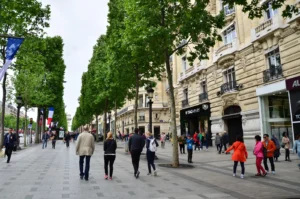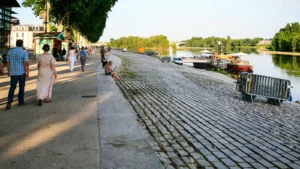Searching for romantic escapes or unique gateways that feel far from ordinary? Dordogne is the answer. This region of southwest France blends medieval villages, winding rivers, and fairy-tale castles into a setting that seems made for couples. Every turn offers charm, intimacy, and the kind of beauty that lingers long after the trip ends.
A château stay here is more than a place to sleep. It’s candlelit dinners in grand dining rooms, walks through rose gardens, and mornings filled with views over rolling countryside. The Dordogne offers couples privacy without compromising its authenticity, a balance that many destinations struggle to achieve.
Among its many treasures, Château de Lasfonds stands out. Nestled near Brantôme, this restored estate combines history with modern comforts — private gardens, spacious suites, and a serene countryside backdrop.
For couples, it offers both seclusion and adventure, from strolling through local markets to kayaking on the river. It’s proof that in Dordogne, romance isn’t just found. It’s carefully crafted.
Why Choose Dordogne for a Romantic Escape?
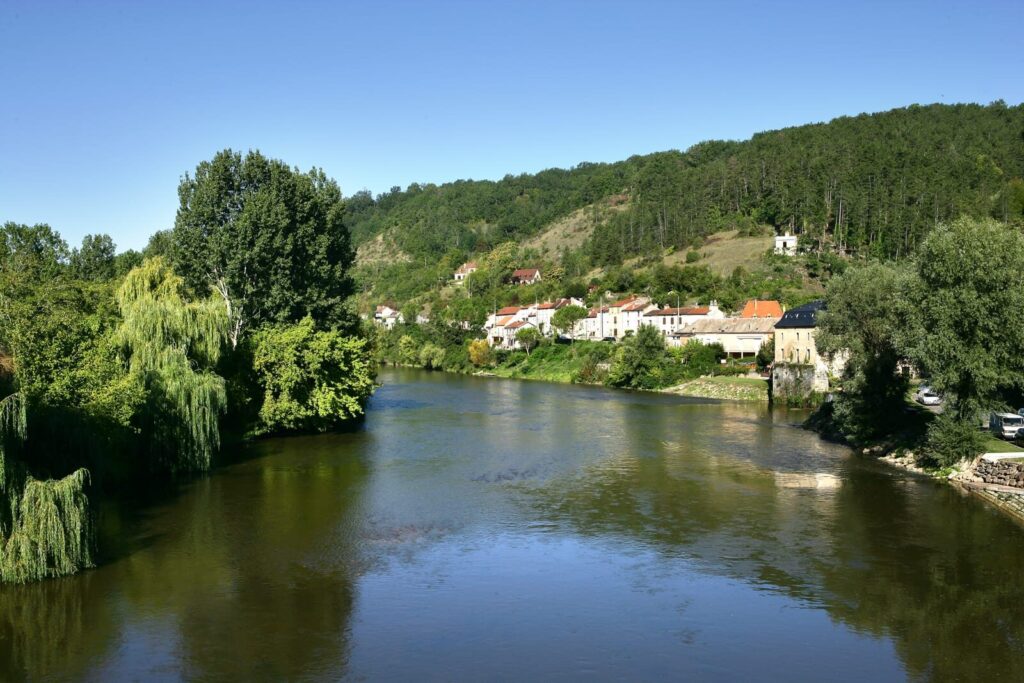
Picturesque Scenery & History Together
Dordogne is a tapestry woven of rolling valleys, rivers like the Vézère and Dordogne, dense forests, and perched medieval towns. Castles, crown cliffs, stone bridges arc over gentle waters, and tiny hamlets cling to hillsides.
You get history everywhere — prehistoric cave paintings, fortified castles, châteaux rebuilt over centuries — but it doesn’t feel like a museum. It feels alive.
Quieter & More Authentic than the Big Names
If you’ve considered Loire Valley châteaux, Provence vineyards, or the Côte d’Azur, Dordogne offers something more intimate. Yes, Loire has grand châteaux, Provence has lavender and sunshine, and the Riviera has glamour — but they also attract droves of tourists, especially in summer.
Dordogne, while not unknown, tends to retain more serenity. The crowds thin out earlier, the villages are smaller, and the rhythms of life feel more grounded.
Seasons That Add Layers of Romance
- Spring: Orchard blossoms, fresh greens, mild weather, rivers flowing strong.
- Summer: Lavender, long daylight hours, outdoor dinners, festivals, and markets full of color and scent.
- Autumn: Harvests, mushrooms & truffles, vineyards ablaze with red and gold, cozy evenings by fireplaces.
- Winter: Frost‑tipped mornings, dimming light, châteaux lit by candle and fire, soft hush over the countryside.
Those seasonal changes don’t just change the view — they change how the region feels, and that’s magic for romance.
What Makes a Château Stay Unique?
A château stay in Dordogne isn’t just about old stone walls — it’s about living romance in every moment. Guests can enjoy candlelit dinners served by a private butler, sip wine by roaring fireplaces, or lounge by a pool with nobody else around.
Many estates offer spa rooms or in-suite massages, so couples can unwind without leaving their private retreat. Breakfast often arrives on a terrace with stunning countryside views, transforming simple mornings into lasting memories.
Inside, there’s more than history. Guests can wander libraries lined with leather-bound books, play a quiet game in salons, or sneak away to a rose garden for sunset.
Unlike large hotels, châteaux feel personal and alive, designed for slow days and unhurried nights. It’s that balance of elegance, privacy, and intimacy that makes them unforgettable.
Why Dordogne Châteaux Feel Different
- Fewer tourists = more privacy
- Nature all around — rivers, woods, gardens
- Local hosts who actually live there
- Slower pace that encourages connection
- Better value compared to Loire or Provence
If you’re craving authenticity, intimacy, and space just to be together, Dordogne delivers.
Top Romantic and Unique Getaways Near Dordogne
I’ll cover four châteaux in detail that are especially romantic, plus a handful of lesser‑known gems.
Château de Lasfonds
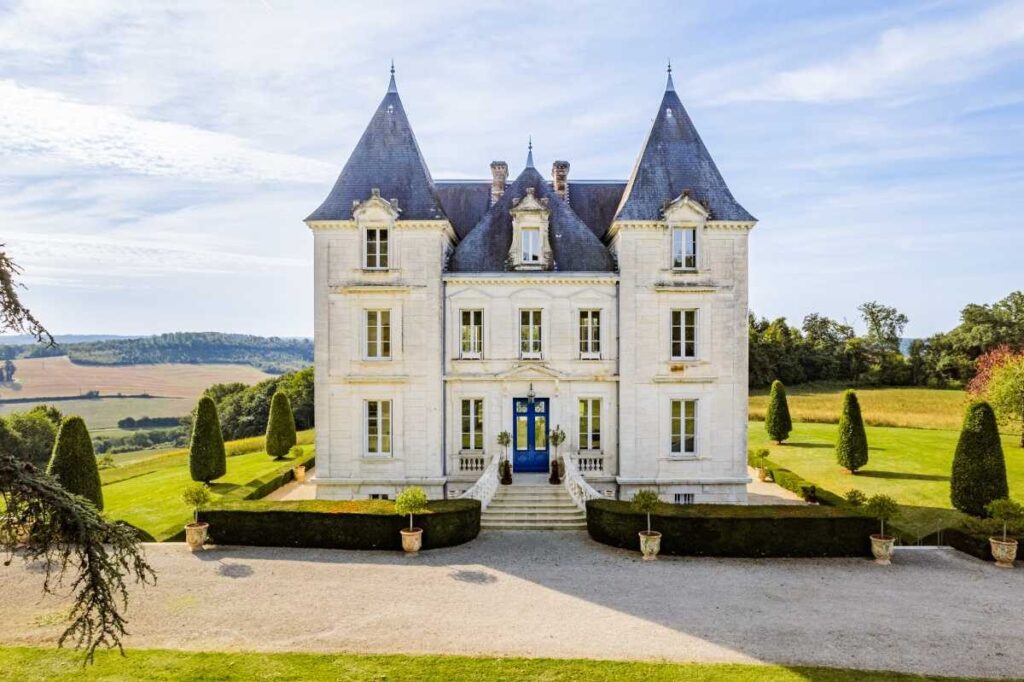
- Setting & Location: The Château de Lasfonds is situated on the border between the Périgord and Charente regions, approximately one hour from Périgueux. It’s perched up on a hill, in countryside that offers sweeping green landscapes.
- Architecture & Features: Built between 1849 and 1893, Lasfonds is a 19th-century château featuring Neo-Gothic turrets, Renaissance touches, stained glass, monumental staircases, exposed beams, and buttresses. The restoration work preserves those classic features while adding modern comforts.
Inside, there are four main bedrooms in the château, plus guest houses (gîtes) and outbuildings. Some units have private bathrooms, exposed beams, and kitchenettes, among other amenities. Outdoors, you’ll find 6.5 hectares of grounds, with a heated pool, gardens, terraces, outdoor kitchens, and lounge spaces.
Why It’s Romantic for Couples
Because you can have large parts of the estate to yourselves — the château or the gîtes — privacy is easy. The views are excellent, with terraces, gardens, and rooms suited for cozy evenings by the fire. Plus, it strikes a balance: elegant yet comfortable.
Activities & Nearby Experiences
From Lasfonds, you can easily reach countryside walks, local markets, perhaps truffle‑hunting in the autumn, wine tasting in nearby vineyards, and kayaking in rivers. Guide‑du‑Périgord mentions the property as a “privileged setting” for relaxation in nature.
Practical Details
It is available year‑round. You’ll want a car to explore, as some of the smaller villages/restaurants are off the beaten path. Rooms are equipped with air conditioning (important in summer) and heating/fireplaces (for cooler months).
Château de Hautefort
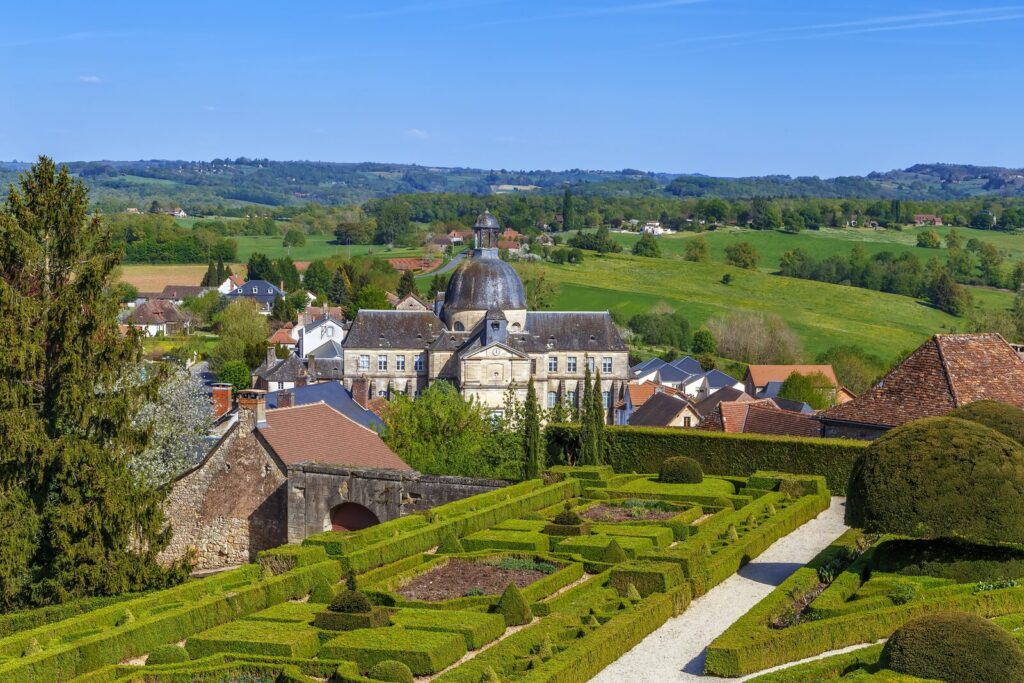
Hautefort castle garden and surroundings, France
- History & Beauty: Château de Hautefort is one of the grandest classical châteaux in the region. Its origins go back many centuries (medieval fortifications evolved over time), and its architecture is more formal, more majestic than some of the more rustic rural châteaux. The gardens are formal, and the park also features an English-style design, allowing nature and architecture to complement each other.
- Romantic Appeal: If you love sweeping views, grand architecture, formal gardens, and elegant interiors, Hautefort delivers. It’s perfect for couples who want more “elegant luxury” with a strong sense of heritage—enjoying evening light in gardens, moonlight on statues or reflecting ponds, fine dining, and tranquility.
- Why Visit & Stay: You can tour its gardens, often attend cultural events held at Hautefort (concerts, exhibitions, depending on the season). Additionally, its location makes it an excellent base for exploring the surrounding Périgord Noir, including its vibrant markets, charming villages, and scenic rivers.
- Things to Note: It’s more formal, which means higher upkeep, probably more expensive, and maybe fewer rustic quirks. If you’re looking for something very off‑grid and super private, you might prefer a smaller château or converted manor. But for sheer romantic pageantry, Hautefort is up there.
Château de Losse
The Château de Losse is a Renaissance‑era château built around 1575, set on the foundations of a much older medieval fortress. It overlooks the Vézère River in Thonac, in the Périgord region. It has been preserved/restored and was listed as a Historic Monument in 1928.
Jean II de Losse, the Marquis, built the Renaissance Hall within the medieval stronghold, retaining its defensive features, including curtain walls, moats, and towers.
- Gardens & Scenic Points: The château gardens (designated a “Jardin Remarquable”) are elegant, featuring terraces, clipped hedges, rose walkways, arbors, and stunning views over the river. There are ‘green rooms’ in the garden, watered paths, balcony terraces, and the terrace built on the cliff, which offers dramatic vistas of the Vézère valley.
- Romantic Touches: Couples will love the moats, defensive gatehouse, candlelit rooms, the terrace looking over water, and the sense of both serenity and history. Picnic by the river downstream, watch the light shift in the courtyard, listen to birdcalls in the garden.
- Visitor Practicalities: Open roughly mid‑April through early November; hours vary (longer in summer). There are guided tours and audio guides—some of which involve climbing stairs; however, limited accessibility is available for individuals with mobility impairments.
Note: Losse is more a château to visit rather than one where you stay overnight; many visitors stay in nearby villages, inns, or rent a château property and do day trips to Losse.
Château des Milandes
Built in 1489 by François de Caumont, originally as a more comfortable, elegant alternative to their older, harsher fortress at Castelnaud. It mixes Gothic and Renaissance styles, with later additions.
In the 20th century, it became the home of Josephine Baker (buying the Château in 1947). Her touch gives the place added cultural weight: civil rights, artistic legacy, internationalism, and creativity. The château reflects not just aristocratic history but modern stories of love, art, and activism.
- Gardens & Visual Appeal: The gardens are beautiful — a blend of formal French gardens and parkland, featuring intimate paths, magnolia trees, topiary, and stunning views over the Dordogne. The château sits sheltered yet elevated, offering views of the river valley.
- What Couples Can Experience There: Tours through the rooms (some dedicated to Josephine Baker’s life, featuring her costumes and projects), bird of prey demonstrations, strolling through the gardens, and perhaps a meal at the château’s brasserie, accompanied by summer events. For those who love stories and emotional texture in their stay, Milandes adds something special.
- Stay vs. Visit: It’s primarily a museum/gardens / cultural site; lodging is not generally located within the château itself (though there are many charming guesthouses and small hotels nearby). So if you’re planning to stay in the château, Milandes is more something to integrate into a romantic itinerary rather than the lodging base.
Additional Hidden Gems
Here are a few less well‑known or smaller château‑style properties/manors that often don’t make big guidebooks but are excellent for couples seeking quiet and charm:
- Smaller manoirs or converted châteaux in the Périgord Vert or Périgord Blanc, with a few bedrooms only, surrounded by woods and farms.
- Château‑guesthouses on estates with vineyards or orchards, where you might get your own terrace, private pool, and breakfast made from local produce.
- Properties with strong local connections — maybe an owner who is a vintner, or a cook, or whose family has lived there for generations, meaning more stories and warmth.
One example is Château de Lasfonds’ guest houses/outbuildings, which offer that quieter, private feeling even when the main château is whole.
Romantic Experiences Couples Can Enjoy
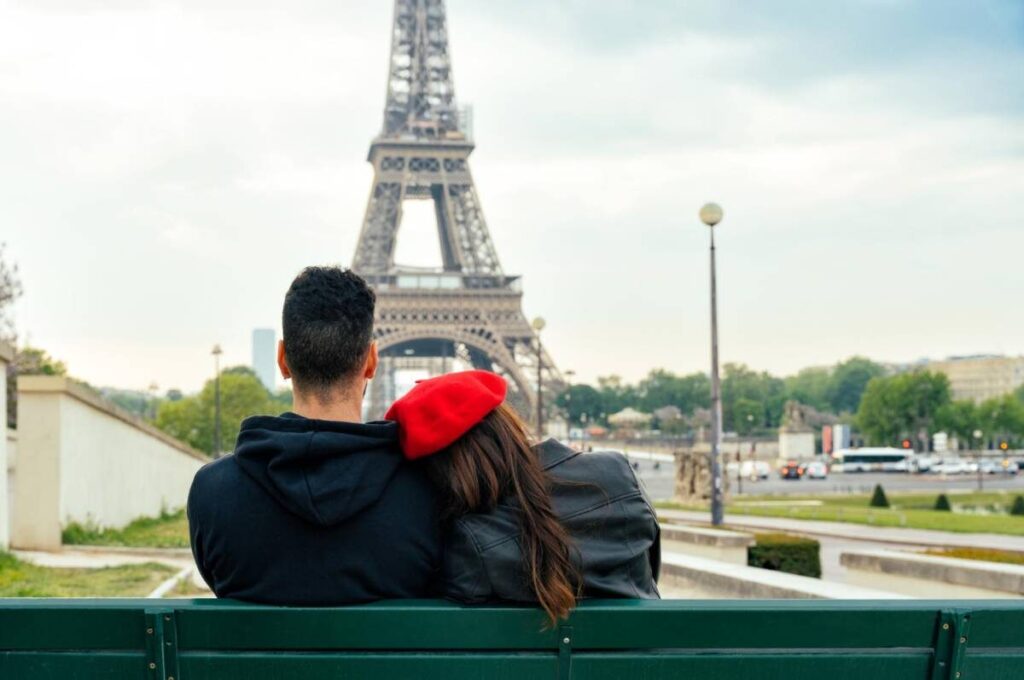
A château stay in Dordogne is about more than sleeping in style — it’s about sinking into the region’s rhythm and sharing experiences that feel both authentic and unforgettable.
Whether you’re into food, adventure, or simply slowing down together, here’s how to fill your days with romance — now with current data to show just how popular and memorable these experiences are.
Wine & Gastronomy: From Vineyard Tastings to Truffle Hunts
Dordogne is a foodie’s paradise, and for couples, that means indulgence with a side of intimacy. You’ll find:
- Vineyard tours in nearby Bergerac or Pécharmant, often family‑run, where tastings happen in candlelit caves or under the vines. Wine tasting & winery tours in Dordogne are highly rated; as of mid-2025, there are over 24 top wine-tour/winery experiences listed, many of which are explicitly recommended by couples.
- Truffle hunting, especially in winter, guided by trained dogs and local experts — earthy, exciting, and often followed by a truffle‑heavy meal.
- Local markets & artisan food are also central: for example, the Issigeac Sunday market draws up to 15,000 people on market days.
Outdoor Activities: For Adventurous (or Lazy) Days
Nature in Dordogne isn’t just a backdrop — it’s part of the experience. Romantic ways to explore include:
- Kayaking or canoeing down the Dordogne or Vézère rivers. Glide under stone bridges, past cliffside castles, and stop for riverside lunches.
- Hot‑air balloon rides at sunrise — a bucket‑list way to see the landscape unfold beneath you.
- Cycling routes, like the Voie Verte trails, wind through sunflower fields and sleepy villages.
- Horseback rides through forested trails and vineyard paths, often arranged through your château host.
One stat to show how in demand these kinds of nature/relaxation experiences are: there are hundreds of thousands of traveler reviews of couple‑friendly outdoor & vineyard experiences in Dordogne listed across 2024‑2025.
Cultural Immersion: Wandering Through Time
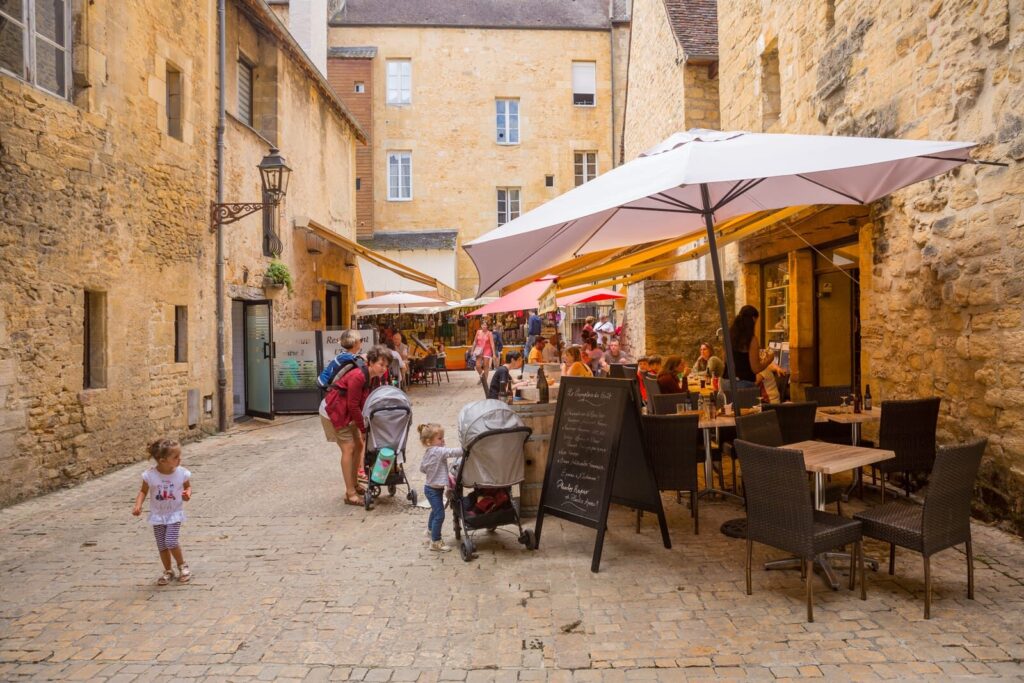
Some of the region’s most romantic moments happen when you just wander.
- Stroll through Sarlat-la-Canéda, with its medieval architecture and softly lit squares, perfect for an evening aperitif.
- Get lost in Brantôme, known as the “Venice of Périgord,” with its abbey, riverside cafés, and stone bridges.
- Visit Domme, a bastide village with panoramic views over the Dordogne Valley — especially dreamy at sunset.
- Join in weekly markets or village festivals where locals gather, music drifts through the air, and wine flows easily.
Local guidebooks & travel blogs in 2024 emphasize these towns as among the top-visited by couples, precisely because of their atmosphere and authenticity.
Wellness & Relaxation: Doing Nothing, Beautifully
Sometimes the best moments come when you stop planning and just soak it in.
- Book a spa treatment if your château offers it — or look for nearby wellness centers with couples’ massages or thermal baths.
- Pack a bottle of wine and a blanket for a private picnic in the château gardens or by the riverbank.
- Take a sunset walk — even a simple stroll through vineyards or nearby trails can feel cinematic in the Dordogne light.
- In cooler months, cozy up by the fireplace with a good book, a glass of Monbazillac (a local sweet wine), and nowhere to be.
Sample 3-Day Romantic Château Itinerary
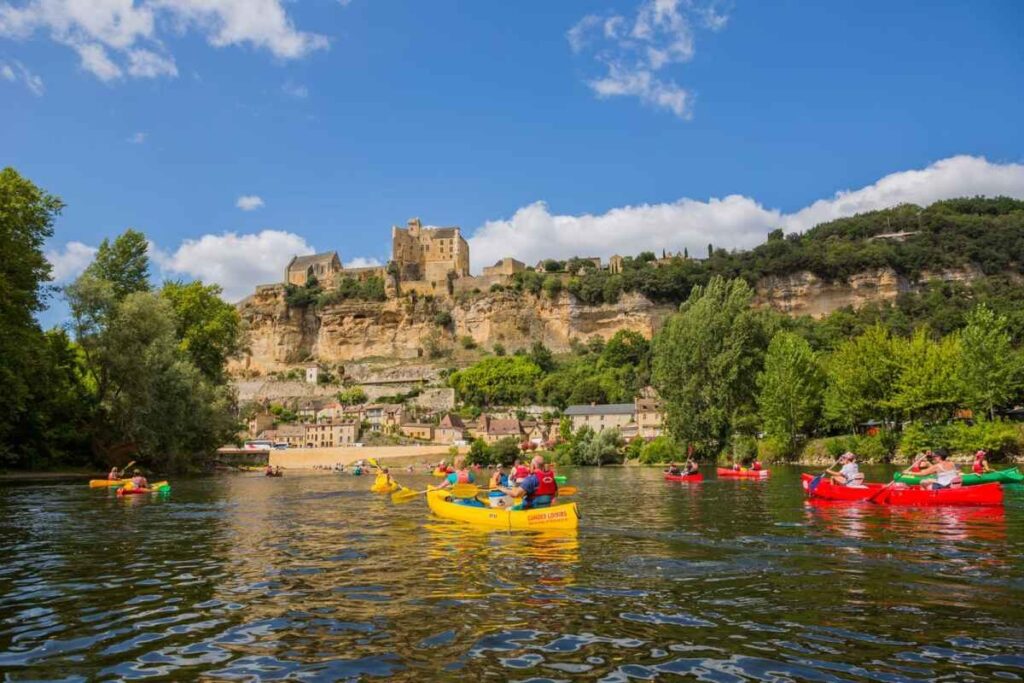
You’ve booked the château. The bags are packed. Now what? Here’s a simple, flexible 3-day itinerary that blends romance, culture, and total relaxation — with room to breathe.
Day 1: Arrival & Unwinding
- Morning: Arrive via Bordeaux or Bergerac airport, collect your rental car, and enjoy the scenic drive through sunflower fields and vineyards.
- Afternoon: Check into your château suite. A private butler welcomes you with champagne and light bites on the terrace. Explore the gardens or take a dip in the heated pool.
- Evening: Enjoy a private, candlelit dinner inside the château’s grand dining room, paired with local Bergerac wine. End the evening with a quiet stroll under the stars or a fireside nightcap.
Day 2: Taste and Adventure
- Morning: Start your day with breakfast served on your balcony, overlooking the countryside. Head out for a guided truffle hunt or a vineyard tour in Pécharmant.
- Midday: Return for a chef-prepared lunch featuring your truffle finds or local cheeses, accompanied by walnut bread.
- Afternoon: Choose between kayaking on the Dordogne River or a hot-air balloon ride at sunset. Both offer breathtaking views of castles, rivers, and valleys.
- Evening: Relax with a spa treatment or couples massage, followed by a private wine tasting in the château’s cellar.
Day 3: Slow Down and Savor
- Morning: Sleep in. Your butler delivers coffee and pastries to your suite. Take a leisurely walk through the estate gardens or ride horses along nearby forest trails.
- Midday: Enjoy a picnic lunch arranged by the château staff, set under oak trees or along the riverside.
- Afternoon: Wander through the medieval streets of Brantôme or Sarlat, stopping for wine and people-watching at a café terrace.
- Evening: Return for one final château dinner — perhaps outdoors under fairy lights. Raise a glass of Monbazillac dessert wine to a trip you’ll never forget.
Ready to Make Unique Gateways Real?
By now, you know Dordogne isn’t just another pretty place — it’s a region built for romance. Winding rivers, golden stone villages, incredible food and wine, and châteaux that feel more like fairy tales than accommodations. And the best part? It’s all real, and it’s more accessible than you think.
A château escape here isn’t about ticking off tourist spots. It’s about long mornings, quiet evenings, and everything in between — just the two of you, surrounded by history, beauty, and peace.
Whether you’re planning a honeymoon, anniversary, surprise proposal, or simply want a few days to reconnect — this is your sign to go for it.
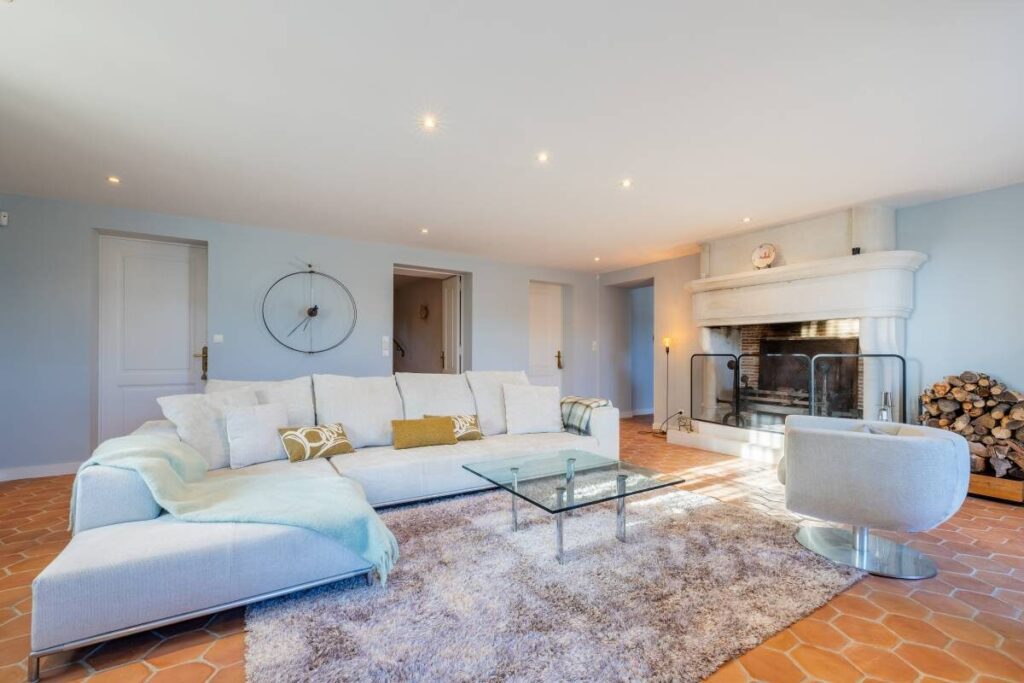
Start with a place like Château de Lasfonds — serene, beautifully restored, and ideally located for day trips, wine tours, or simply doing nothing at all.
Book your château escape now — because some memories are too good to wait for.
FAQ: Unique Gateways Near Dordogne
Top romantic châteaux include Château de Lasfonds for its privacy and countryside charm, Château de Hautefort for grand gardens and evening elegance, Château de Losse overlooking the Vézère River, and Château des Milandes (Josephine Baker’s former home) for cultural history. Hidden gems, such as boutique manoirs in Périgord Vert or Blanc, are great for those who prefer quieter, lesser-known escapes.
Prices vary widely depending on size, luxury, location, and season. Boutique château-hotels can begin around US$150-$250/night for simpler converted manor houses, while more luxurious château resorts with full amenities often cost upwards of €300-€500+ in peak season. Booking off-season or mid-week can bring significant savings.
Late spring (May-June) and early autumn (September) are ideal: mild weather, fewer tourists, harvest season in vineyards, and beautiful foliage. Summer brings long days and more bustle; winter is cozier, with fireplaces and more privacy, though some properties may have reduced services. For romance + balanced weather, aim for shoulder seasons
Absolutely. Many châteaux are intimate, romantic, rich in atmosphere, and offer additional services such as private dinners, spa treatments, guided garden walks, or wine tastings. If privacy matters, choose smaller estates or outbuildings attached to a château (like those at Château de Lasfonds) so you feel like the place is yours, not just another hotel.
Yes — wine culture is deeply tied to the region. Many château-hotels partner with local vineyards (particularly around Bergerac, Pécharmant) for tastings, cellar tours, or even pairing dinners. Some hosts arrange private tastings or vineyard visits as part of your stay, especially in the shoulder seasons when vineyards are less crowded.
Yes, in many cases. Some châteaux are structured so you can rent the whole estate or large sections (guest houses/outbuildings) for exclusive use. For example, places like Château de Lasfonds allow renting multiple guest houses or the main château together for groups or couples wanting total privacy. Always confirm with the owner about exclusive availability and what it includes.
Sarlat-la-Canéda stands out with its medieval lanes, evening lights, and top-notch restaurants. Brantôme (“Venice of Périgord”) charms with riverside cafés and an ancient abbey. Domme offers panoramic views over the Dordogne Valley, especially at sunset. Also, small hilltop villages and market towns like Issigeac bring authenticity and quiet romance.
Châteaux can be both. Some properties cater more to couples or romantic escapes, offering intimacy and quiet. Others are more family-oriented with larger rooms, gardens, and activities for children. When traveling with kids, look for château-hotels that list family suites or offer extra beds, and those with outdoor space or nature walks suitable for all ages.
The distance from central Dordogne (e.g., Périgueux) to Bordeaux is approximately 129 km, which translates to a travel time of 1 hour 15 minutes to 90 minutes by car, depending on the exact location and road routes. From Paris it’s much farther — expect 6-7+ hours by car, depending on route and traffic.
Don’t miss foie gras, truffles (especially in winter), walnuts, local cheeses like Cabécou, and duck confit. For wines, try the white Bergerac, Monbazillac dessert wine, and Pécharmant reds. Dining in local bistros or château kitchens can bring out the best flavors and connection to the land.
Autumn tends to win for romance: harvest season, cooler — more comfortable — weather, golden light, fewer tourists, good deals. Summer offers long days and lush landscapes, but can also be hot and busy. If you want vibrancy and warmth, summer works; for intimacy, color, and calm, choose autumn.
Yes—many châteaux offer wedding or special event services. Spaces like gardens, terraces, or under marquees are common. If planning a proposal, many owners will help with private dining, décor, and romantic touches. For weddings, ensure you verify capacity, legal requirements, catering, and accommodations for guests.
Kayaking or canoeing on the rivers, hot-air balloon rides at dawn, hiking vineyard trails, cycling through sunlit fields, picnicking beside water, and forest walks. For adventure plus calm, the Vézère and Dordogne rivers are ideal. Many couples also explore prehistoric caves or take scenic drives between hilltop villages.
Loire Valley châteaux tend to be more grand, often with extensive gardens, heavy tourism, and formal architecture. Dordogne, by contrast, offers more rustic charm, fewer crowds, deeper immersion in countryside food & wine, and more tranquility. If you prefer romance and authenticity over scale and polish, the Dordogne might suit you better.

